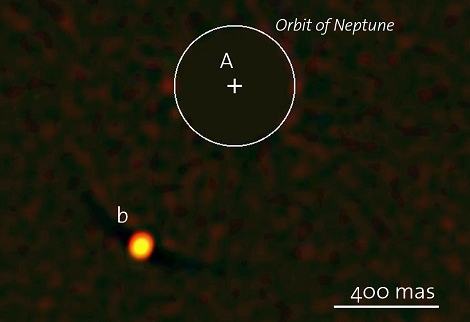The Sphere instrument, installed on ESO's Very Large Telescope (VLT) in Chile, has for the first time obtained a shot of an exoplanet using direct detection methods. Its ONERA adaptive optics system, at the core of the instrument, is one of the keys to this success.
Located 385 light years away from the Solar System, this giant gaseous planet is far from its star: at 3 times the distance between the Sun and the farthest planet of our Solar System - Neptune - more than 14 billion kilometers. Its estimated mass is equivalent to 6 to 12 times that of Jupiter and its temperature is between1000 and 1400 degrees Celsius. Its spectrum reveals the existence of water in its atmosphere and the probable presence of clouds – which are characteristics similar to those of some of the exoplanets imaged so far.

© ESO/SPHERE Consortium/G. Chauvin et al.
Exoplanet HIP65426 (VLT/SPHERE). La lumière de l'étoile centrale (A) a été masquée par un coronographe
Real-time correction of images using the deformable mirror, which corrects atmospheric turbulence effects over 1300 times per second with nanometric accuracy, made it possible, among other technological feats, to make this discovery and to access all of these data on this exoplanet. This system, which has become an integral part of Sphere, is based on ONERA's know-how in adaptive optics.

© Claude DELHAYE/ESO/CNRS Phototheque
One of the four main telescopes of the Very Large Telescope at Mount Paranal in Chile
Since January 2015, the instrument has been open to the world's astronomical community and discoveries have continued to be made (in particular, the imaging of protoplanetary discs - gas discs from which planets or smaller bodies are formed) already published over 100 times.
Voir aussi le communiqué de presse du CNRS "Première découverte d'une exoplanète pour Sphere"







